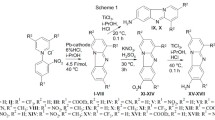Summary
A number of compounds were screened for their effects on growth of the yeast cells ofHistoplasma capsulatum. Included were penicillin and related compounds, sulfhydryl inhibitors, various organic sulfur compounds recently synthesized for the first time, and compounds structurally related to the required metabolites, thiamine and cystine or cysteine. Cephalothin was the only one of the penicillin related compounds which inhibited growth. This occurred only when a high concentration (8.3 × 10−4 M) was used. Of the analogues of cystine tested, allylglycine had the greatest inhibitory effect on growth of the yeast cells in the synthetic medium, but it failed to inhibit growth in a complex medium containing peptones and plasma. Among the sulfhydryl inhibitors, the maleimides were the most effective, producing complete inhibition of growth in the peptone medium at 10µg/ml or less. At subinhibitory concentrations the cultures tended to become mycelial. The action of the maleimides was reversed by cystine over a range of concentrations. At low concentrations, some of the disulfide derivatives of thiamine stimulated growth equally as well as thiamine, but at concentrations of 100 to 150µg/ml, they completely inhibited growth. On the basis of results obtained to date, three classes of the new organic sulfur compounds being tested offer promise as sources of potentially useful chemotherapeutic agents. These classes, which differ widely in structure, are as follows: the benzyl decylaminoethyl disulfides, the acyl disulfides, and the trithiopercarbamates.
Similar content being viewed by others
References
Aposhian, H. V., Wolff, S. M. &Rhea, W. G., Jr. 1957. The inhibition of serine metabolism inLeuconostoc mesenteroides P-60. I. Microbiological activity of D-and L-penicillamine. Arch. Biochem. Biophys.71: 442–450.
Buckman, J. D., Johnson, B. S. &Field, L. 1966. The antimicrobial activities of carbonyl and thiocarbamoyl disulfides. Canad. J. Microbiol.12: 1263–1267.
Dittmer, K. 1950. The structural bases of some amino acid antagonists and their microbiological properties. Ann. N.Y. Acad. Sci.52: 1274–1301.
Fell, K. V. &Stephenson, E. L. 1953. The effect of penicillin and penicillamine on chick growth when injected and when fed orally. Poultry Sci.32 (6): 1092–1093.
Friedmann, E., Marrian, D. H. &Simon-Reus, I. 1949. Antimitotic action of maleinimide and related substances. Brit. J. Pharmacol.4: 105–108.
Fujiwara, M., Sasakawa, S., Itokawa, Y. &Ikeda, K. 1964. Urinary excretion of thiamine propyl disulfide-S35 after administration. J. Vitam.10: 55–69.
Horsfall, J. G. 1956. Principals of Fungicidal Action, p. 171–185. Chronica Botanica Co. Waltham, Mass.
Komoriyama, K. 1962. Pharmacological studies on o-benzoyl thiamine disulfide. J. Showa Med. Ass. (Japanese)21: 777–791.
Larsh, H. W., Hinton, A. &Silberg, S. L. The use of the tissue culture method in evaluating antifungal agents against systematic fungi. In: Antibiotics Annual, 1957–58, New York, Medical Encyclopedia, Inc., 1958, p. 988–991.
Markov, K. Iw. &Saev, G. K. 1957. Das Penicillin — ein spezifischer Wachstumsfaktor für “Staphylokokken”. Zbl. Parasit. Infek. und Hyg.168: 302–312.
McVeigh, I. &Morton, K. 1965. Nutritional studies ofHistoplasma capsulatum. Mycopath. et Mycol. appl.25: 294–309.
Němečková, A., Maturová, M., Malinský, J. &Šantavy, F. 1959. The biological effectiveness of the homologous series of imides of malic and maleic acid. Physiol. Bohemosloslovenica8: 123–130.
Rogers, E. F., Clark, R. L., Pessolano A. A. Becker, H. J., Leanza, W. J., Sarett, L. H., Cuckler, A. C., McManus, E., Garzillo, M., Malanga, C., Ott, W. H., Dickinson, A. M. &Iderstine, A. V. 1960. Antiparisitic Drugs. III. Thiamine reversible coccidiostats. J. Amer. chem. Soc.82: 2974.
Thorne, G. D. &Ludwig, R. A. 1962. The Dithiocarbamates and related compounds, p. 207–223. Elsevier Publishing Co., New York, N.Y.
Author information
Authors and Affiliations
Additional information
This investigation was supported by Public Health Service Research Grant AI-03524 from the National Institute of Allergy and Infectious Diseases.
Rights and permissions
About this article
Cite this article
McVeigh, I., Evans, Z. Effects of various compounds on growth of yeast cells of Histoplasma capsulatum. Mycopathologia et Mycologia Applicata 35, 313–323 (1968). https://doi.org/10.1007/BF02050747
Issue Date:
DOI: https://doi.org/10.1007/BF02050747




